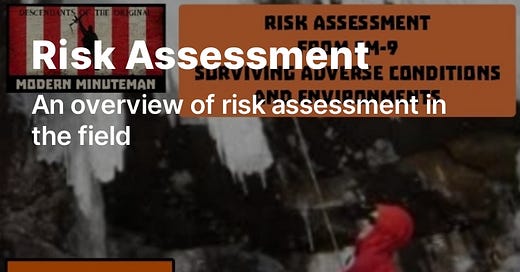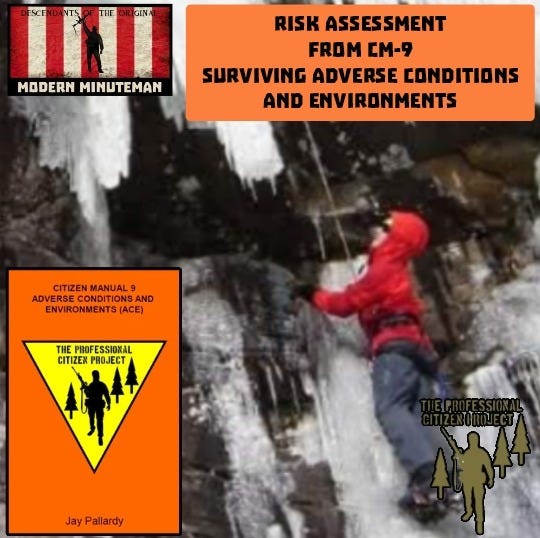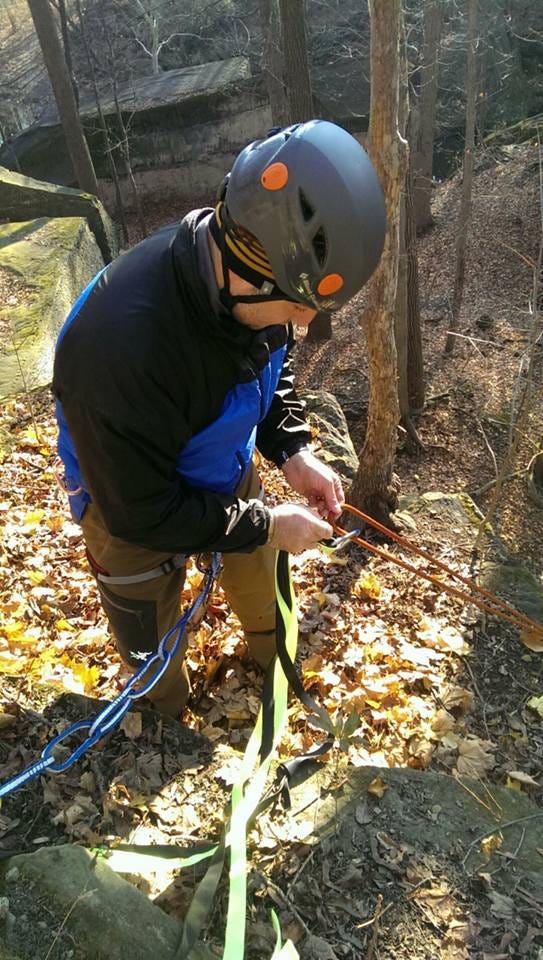The following is a brief excerpt from CM-9 Surviving Adverse Conditions and Environments with The Professional Citizen Project. Today we have more and more folks heading into the outdoors and with this increase comes more folks who may not have the necessary experience or skills to safely deal with accidents, or know how to mitigate the risks associated with accidents in the field…
Personal and group safety is paramount in the field. Every accident is different, but the contributing factors are very often the same. Inadequate experience and skill often lead to errors in judgement, poor tactics, and improper use of gear. This isn’t saying that experienced folks don’t have accidents, but they are able to mitigate the occurrence of them and lessen the severity of them. The Professional Citizen must place a high priority on individual and group safety and instill safe practice into the way they operate.
Risk
We, as individuals, need to manage risks. This isn’t an adventure story with Arnold Schwarzenegger as the hero surviving 200 against 1 odds with nothing but a big knife and bulging muscles. We need to think our way through problems, all the while analyzing and evaluating, making decisions based on sound reasoning and leadership principles, all the while constantly looking for dangers and thinking ahead on what needs to be done to keep everyone safe while still pushing for a successful outing.
Risk Assessment
I talk about risk assessment a lot when putting together trips and exercises. There is actually a formula to help in deciding on a plan of action. The formula looks like this:
Risk = Severity x Probability x Time
So, look at this as there being a more severe risk when there is an increase in any of the three variables listed above. The likely severity of an accident, the probability an accident could occur, and the length of time exposed to that risk.
Let’s consider this, you’re planning a 48 hour field exercise where you are patrolling a lengthy property line and setting up a temporary field camp. The weather forecast is for a 70% chance of rain with nighttime temperatures dropping into the 40’s. Half your group is new to conducting foot patrols. You’re thinking of sending the patrol out with bare bones sustainment kit. What is the risk assessment?
Let’s work out the risk formula:
Severity: A cold, wet night out in a bivouac could have serious consequences with minimal kit for staying warm and dry, especially for the new guys in the group. So, severity is high for hypothermia.
Probability: It is unlikely you would fall to the cold and wetness through past experiences but the new guys in the group have never spent a night out under such conditions. Their inexperience increases the likelihood of succumbing to the conditions. This increases the probability of hyperthermia for someone in the group.
Time: You will be out in the field for 48 hours so your exposure to the elements is high. Working in the field for the new guys will be tiresome. Time of exposure to the elements is high.
So, you can see, according to the formula, there is no simple answer but, it does point to a pretty obvious solution.
Probable Solution: Have the guys take extra warm and wet weather gear and be prepared to have a hot camp.
By taking the time to look at the risks associated with any outing you can be better prepared and raise your chances of success.
Overall, the objectives for our risk assessments are to keep our perceived risks in line with the real risks, which helps to establish the amount of acceptable risk we are willing to take to achieve a goal or objective. This can be the culmination of all other safety measures including our gear, training, and experience along with the possible hazards regarding weather and terrain. When you understand the way these all work together, you will then gain a better understanding of acceptable risk and how much is right for you and your group. But don’t let your judgement be clouded by your own overconfidence or wishful thinking, this can cause a dangerous level of risk that you may not really be ready to undertake.
Climbers on big mountains encounter this dangerous level of risk too often. They let their perceived risks get out of balance with the real risks and then accept that risk in a way that they normally wouldn’t accept. They can be tempted by glory, by being the first, or from the standpoint of feeling that nothing bad happened the last time that level of risk was taken.
The moral of the story here with risk is to be able to pause and take inventory of the situation, of the people it involves, and to work out how best to achieve the desired result with the lowest chance of failure. I have developed a strong sense of a gut instinct that has served me well in the mountains. But a lot of that is due to experience. I’ve been lost, I’ve been cold, I’ve been late, and I have failed on far more peaks than I can list here. But it has helped develop a much stronger understanding of risk assessment and how to use it to breed success in the field.
For more on emergency prevention and response, check out CM-9 Surviving Adverse Conditions and Environments from The Professional Citizen Project.
The Professional Citizen Project manuals include:
CM-1 Individual Tactical Skills
CM-2 Reconnaissance
CM-3 AR Pattern Rifle and Carbine
CM-4 Land Navigation
CM-5 Teenage Prepper
CM-8 The Modern Minuteman
CM-9 Adverse Conditions and Environments (ACE)





